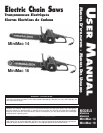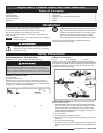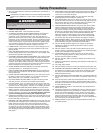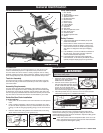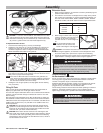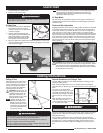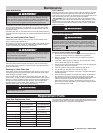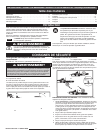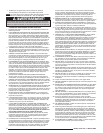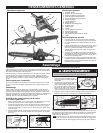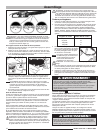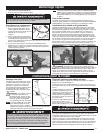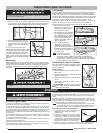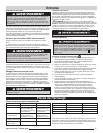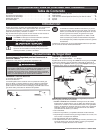
Toll Free Hot Line: 1-800-521-8559 5
CAUTION: If a chain is TOO LOOSE or TOO TIGHT, the bar, chain
and saw bearings will wear more rapidly. Study the figure above for
information concerning correct cold tension (A), correct warm tension
(B), and as a guide for when saw chain needs adjustment (C).
To Adjust Saw Chain Tension:
1. Loosen the bar retaining nuts (J) so they are hand tight.
2. Holding the nose of the bar up, use the screwdriver or scrench if pro-
vided in your User’s Kit to turn the guide bar adjustment screw (F)
clockwise to tighten the chain. Turning the screw COUNTERCLOCK-
WISE LOOSENS THE CHAIN on the guide bar.
3. After adjustment and while wearing heavy duty work gloves, move the
saw chain back and forth on the guide bar to be sure the chain moves
freely and is in proper mesh with sprocket.
If the chain is difficult to rotate or if it binds on the guide bar, too
much tension has been applied and must be adjusted. To decrease
tension, turn the adjustment screw counterclockwise slowly. Move
the chain back and forth until it moves freely.
4. Holding the nose in upper position, securely tighten the bar retaining
nuts (70 inch lbs.).
Filling Oil Tank
Using a funnel, fill oil tank with McCulloch Chain, Bar and Sprocket oil.
Wipe up any spills. Make sure no dirt gets into the oil tank.
The saw chain requires lubrication while in use to minimize friction with the
guide bar. The oil tank holds enough to lubricate the chain for 12-15 min-
utes of sawing.
We recommend using McCulloch Chain, Bar and Sprocket Oil, which con-
tains additives to reduce friction wear and reduce resin residue formations.
If McCulloch Chain, Bar and Sprocket Oil is not available, use SAE 30 non-
additive motor oil above 40˚F (5˚C) and SAE 10 non-additive motor oil at
lower temperatures.
CAUTION: The oil tank level should be frequently checked during
operation to avoid starving the bar and chain of lubrication. The oil
tank level can be checked in the inspection slot provided on the left
side of the saw. (see chain and bar lubrication)
CAUTION: Never starve the bar and chain of oil. Running the saw
DRY or with TOO LITTLE OIL will decrease cutting efficiency, shorten
saw chain life and cause rapid dulling of the chain and overheating
which dulls the chain and wears the bar. When this occurs, smoke or
bar discoloration can be seen.
Extension Cords
1. When using the appliance, an extension cord with a polarized plug and
polarized outlet must be used
2. The extension cord must be of adequate size for safety and to prevent
loss of power and overheating. It must be specifically intended for out-
door use and be marked SW-A, SOW-A, STOW-A, SJW-A, SJOW-A
SJTOW-A, SJTW-A, OR SJTW. Follow cord size requirements below:
Cord Length AWG Cord Size
25 Feet 16
50 Feet 16
100 Feet 14
150 Feet 12
3. When using an electric chain saw, plug
it into the extension cord only when you
are ready to cut wood. Connect the
extension cord to a 110/120 voltage out-
let.
To prevent disconnection of the
extension cord, tie a loose knot
before connecting the ends together.
CAUTION: A cord that is hot to the touch is overloaded.
4. When using the appliance, an extension cord of adequate size must
be used for safety and to prevent loss of power and overheating.
5. Inspect the extension power cord for loose or exposed wires and dam-
aged insulation. If damaged, replace before using the appliance.
Double Insulation
No Serviceable Parts Inside
Do not use if the cord or plug is damaged. Your appliance is double insulat-
ed to help protect against electric shock. Double insulation construction
consists of 2 separate “layers” of electrical insulation.
Appliances built with this insulation system are not intended to be ground-
ed. As a result, the extension cord used with your appliance can be
plugged into any conventional 120 volt electrical outlet.
Normal safety precautions must be observed when operating an electrical
appliance. The double insulation system is only for added protection
against injury resulting from a possible internal electrical insulation failure.
NOTE
NOTE
Assembly
A
C
B
Chain Tensions
J
F
Do not operate your chain saw in a wet or damp environment. Do not
expose the saw to rain, snow or sleet. Moisture will cause short circuits.
Replace or repair any damaged or frayed extension cords before using
your saw.
Keep the cord away from the cutting area and position the cord so that it
will not be caught on branches or other objects during cutting.
Your double insulated appliance has no serviceable parts inside. Do not
attempt to repair it yourself. For service information, contact the
McCulloch Product Service Department toll-free number listed on the
back cover of this manual.



